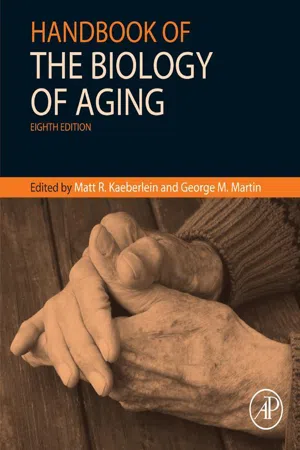
- 576 pages
- English
- ePUB (mobile friendly)
- Available on iOS & Android
Handbook of the Biology of Aging
About This Book
Handbook of the Biology of Aging, Eighth Edition, provides readers with an update on the rapid progress in the research of aging. It is a comprehensive synthesis and review of the latest and most important advances and themes in modern biogerontology, and focuses on the trend of 'big data' approaches in the biological sciences, presenting new strategies to analyze, interpret, and understand the enormous amounts of information being generated through DNA sequencing, transcriptomic, proteomic, and the metabolomics methodologies applied to aging related problems.
The book includes discussions on longevity pathways and interventions that modulate aging, innovative new tools that facilitate systems-level approaches to aging research, the mTOR pathway and its importance in age-related phenotypes, new strategies to pharmacologically modulate the mTOR pathway to delay aging, the importance of sirtuins and the hypoxic response in aging, and how various pathways interact within the context of aging as a complex genetic trait, amongst others.
- Covers the key areas in biological gerontology research in one volume, with an 80% update from the previous edition
- Edited by Matt Kaeberlein and George Martin, highly respected voices and researchers within the biology of aging discipline
- Assists basic researchers in keeping abreast of research and clinical findings outside their subdiscipline
- Presents information that will help medical, behavioral, and social gerontologists in understanding what basic scientists and clinicians are discovering
- New chapters on genetics, evolutionary biology, bone aging, and epigenetic control
- Provides a close examination of the diverse research being conducted today in the study of the biology of aging, detailing recent breakthroughs and potential new directions
Frequently asked questions
Information
Longevity as a Complex Genetic Trait
Keywords
Introduction
Defining the Aging Gene-Space
Direct Screens for Genetic Longevity Determinants
RNAi Screens in Nematodes
Table of contents
- Cover image
- Title page
- Table of Contents
- Copyright
- Foreword
- Preface
- About the Editors
- List of Contributors
- Part I: Basic Mechanisms of Aging: Models and Systems
- Part II: The Pathobiology of Human Aging
- Author Index
- Subject Index